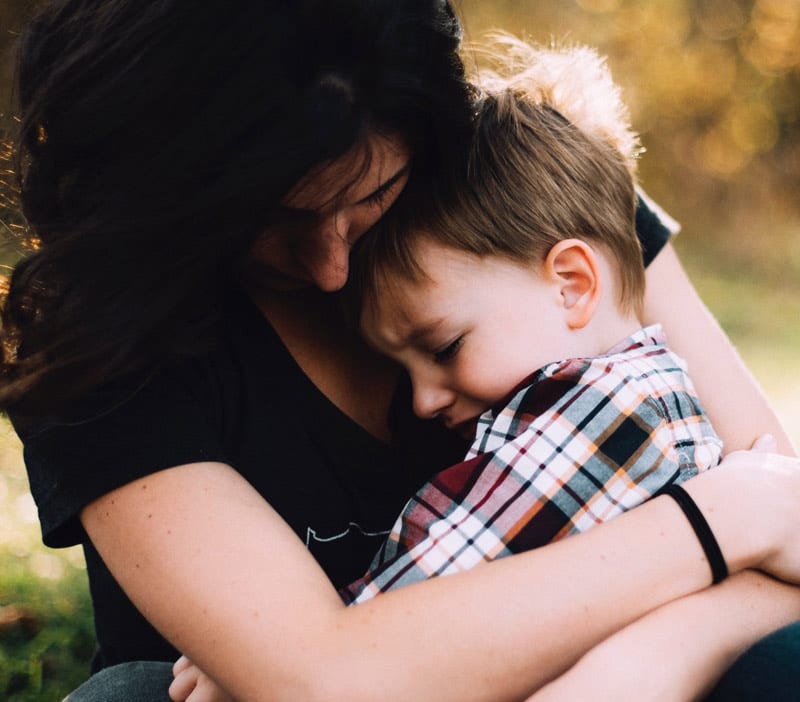According to the Anxiety and Depression Association of America, one in eight children is diagnosed with an anxiety disorder (Boyle, 2016, p 520). Anxiety affects many aspects of children’s lives. It will appear in their thought processes, causing them to believe they are in constant danger or under a constant threat. Anxiety manifests itself in physical symptoms, such as a persistent headache or tummy ache. Finally, anxiety presents itself in children’s behaviors. They may rock, fidget, cry, shake, or shut down completely (Rapee et al., 2008, p 27-28). Having fears is a normal and healthy part of your child’s development. But when it comes to the point that those fears interfere with daily living, it is very easy for caregivers to become burned out.
My daughter has panic attacks. Some weeks, we will skate through effortlessly, with no tears, shaking, curling up into the fetal position. Other weeks, attack after attack, rock her little body, and I am drained to my core. So, as caregivers to these little people who battle anxiety, how do we avoid burnout so that we can continue to give them the support that they need?
To begin with, Rapee et al. (2008) recommend that we stop taking full ownership of our children’s anxiety by attempting to remove all barriers that might trigger anxious feelings in them. “Children can only learn that situations are not dangerous, and that they can cope, if they are forced to experience the situation” (Rapee et. al, 2008, p 116).
One day, my fourth grader with the panic attacks texted me frantically several times in a row, wanting me to trek from my classroom to hers on the other side of the building to tell her teacher that she did not understand the math assignment. My heart hurt for her because I knew the panic she was feeling as she struggled. However, learning to advocate for herself is a life skill, and she does not do that well yet. Moreover, she is not going to learn if I fight all her battles for her. I told her to put her cell phone away and ask her teacher for help. She was angry, and initially, she refused. However, I was informed that she asked for help after it became apparent I really was not going to come talk to her teacher for her.
Next, an unregulated adult will never be able to regulate a child in the throes of anxiety. It is imperative to master the art of walking away to gather yourself when necessary. It is okay to admit that you need a few minutes and table the discussion before it becomes unproductive. Rapee et al. (2008) suggest getting your partner, a friend, etc., to sit with your child if he or she needs supervision (to alleviate the risk for self-harm or destructive behaviors) while you gather yourself.
In my area, we are currently engaged in distance learning due to the pandemic. This means that there are days when I am subject to my daughter’s anxiety for hours upon hours. By the time evening rolls around and my husband arrives home, I need a break in a big way. I let him have her for a bit, and I take a long bath or go for a run (another stress reliever for me). When I return, I am always in a regulated state and ready to take back over. Not only is it okay to give yourself a breather from your child’s anxiety, but it is also quite critical. Only when you are completely regulated yourself will you truly be a positive coach for your child in managing his or her anxiety.
This third strategy is really tricky for many parents because it is so difficult to not react to your child’s anxious behavior. Rapee et al. (2008) affirm that learning to “remove your attention from your child’s anxious behavior and attending again (and praising) when the anxious behavior has stopped” is a critical skill to utilize in discouraging repetitive anxious behaviors. For example, when my child asks the same irrational question repeatedly, I will say, “I love you, and I have answered your question already. I will not be answering it again.” Then, I do the hard thing. I walk away and refuse to engage until the topic of conversation shifts away from the undesirable topic or behavior. Do not continue to tell your child that you have already answered the question, and do not answer the question over and over. If used consistently over time, this strategy should decrease the undesirable behaviors that stem from anxiety and help develop more cohesion and peace within your home.
About the Author: Brandy Browne is an early childhood educator, family coach, and blogger (see www.unstucks.com for more details) focused on breaking the cycle of generational trauma and building resilient families. Her graduate education focused on parenting and childhood/adolescent development. She resides in Oklahoma with her husband and three children.
References
- Boyle, S. (2016). The conscious parent’s guide to childhood anxiety: A mindful approach for helping your child become calm, resilient, and secure. Adams Media.
- Rapee, R., Wignall, A., Spence, S., Cobham, V., & Lyneham, H. (2008). Helping your anxious child: A step by step guide for parents. New Harbinger Publications.
Photo by Jordan Whitt on Unsplash
The opinions and views expressed in any guest blog post do not necessarily reflect those of www.rtor.org or its sponsor, Laurel House, Inc. The author and www.rtor.org have no affiliations with any products or services mentioned in the article or linked to therein. Guest Authors may have affiliations to products mentioned or linked to in their author bios only.
Recommended for You
- How a Health Cleanse Can Reset Your Body and Mind - April 16, 2025
- The Truth about Relapse in Addiction Recovery - April 14, 2025
- The Power of Peer Support in Mental Health Recovery - April 10, 2025





